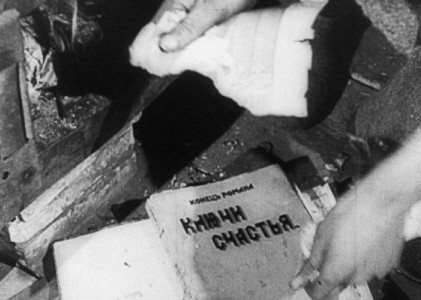Celluloid Manifesto
The following excerpt is adapted from the introduction to Yuri Tsivian's Lines of Resistance: Dziga Vertov and the Twenties (Pordenone, 2004), reprinted with kind permission of the author. MoMA's Vertov retrospective (April 15–June 4) was curated by Tsivian and Joshua Siegel.
Man With a Movie Camera is not merely a movie, it is also a statement, a manifesto, written in celluloid. There are things and images in Dziga Vertov's films that are meant to be read, not just seen. However, spotting those moments and reading those images may not be quite as easy as he thought. Not easy for us, which is understandable: a man of his epoch, Vertov often relied on his epoch's topical emblems, and as a rule topical emblems do not have much of a chance of withstanding the currents of time. Not easy for Vertov's contemporaries, either: most people were ill-prepared (or plainly unwilling) to attend to the screen with an eye as quick and a mind as open as Vertov thought his films deserved. Given this, I find it germane to a book concerned with the press polemic around Vertov if I conclude my introductory remarks by looking at those instances in Vertov's movies when the movie itself attempts to behave polemically.
Here it makes sense to begin with an early and relatively simple example. I take it from Stride, Soviet1 (Shagai, Soviet!), the 1926 six-reel feature commissioned by the City Council of Moscow (called the Moscow Soviet, hence the film's title) in order to popularize this municipal body's achievements over the previous six years or so. It is hard to tell whose idea it was, Vertov's or the commissioners', but it was decided that the bulk of the film's material should be organized around that proven promotional formula, "before and after." The "before" would be the civil war years (the two or three years of hardships and desolation following the October 1917 Revolution), the "after," Moscow today. For whatever reason (it could be, for instance, the dearth of found footage), Vertov opted for shooting the "before" scenes anew. Now, there was nothing exceptional in this kind of solution: bits and pieces of purpose-shot footage are easy to spot in most of Vertov's films. The method itself, Vertov seemed to believe, did not belie his unbending stand against the cinema of fiction (though many critics thought it did): apparently for him these were not falsifications of facts (the phrase he habitually used to condemn fiction), but something like factual re-enactments. A flimsy distinction, I agree, but I doubt if Vertov's cinema could ever have achieved its much admired flexibility had Vertov not settled for this little compromise with his own theory.
In any case, the scenes re-enacted in Stride, Soviet! recall the following facts. No water was running from taps during the civil war years; there was no water in flush toilets, and no fuel for heating, as a result of which everything that could burn, from furniture to books, was fed by hand into makeshift home furnaces.
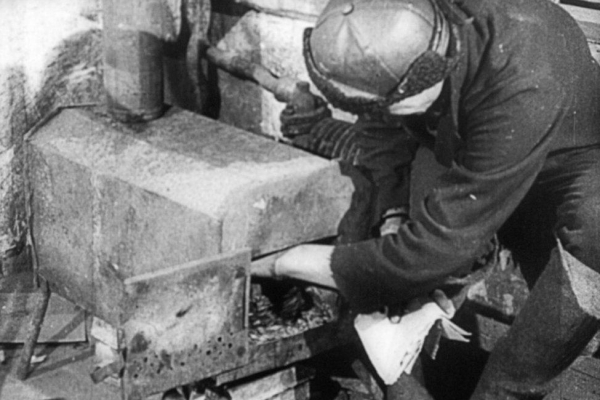
It is the latter scene—the burning of books—which is of interest for the present discussion, for it was hardly by chance that the two books which an anonymous hand is shown shoving into a furnace are The Holy Bible and The Keys to Happiness (Kliuchi schastia), the celebrated bestseller of 1913 by the fashionable novelist Anastasiia Verbitskaia.
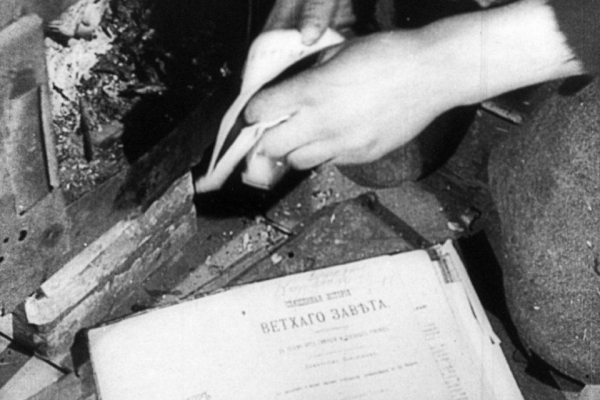
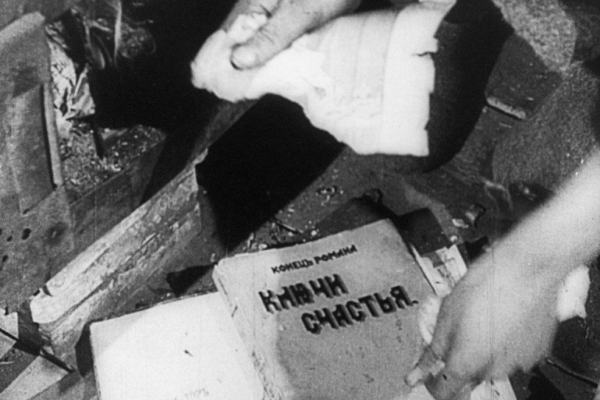
Critics claimed that the instant success of this book—half a million copies sold in four pre-Revolutionary years—was owed primarily to its pretentious vulgarity and the decline of public taste.1 Hardly by chance—but was it on purpose? It would almost appear that, faced with the choice of what books to burn, Vertov simply availed himself of the ones which he (like many others in the 1920s) thought no one was likely to need any more, if he were not at such pains to make the title of the novel and the cover of the Bible visible to us. These books are not props, they are emblems; and the fact that they are consigned to the flames is not about heating—no more than any other auto-da-fe of which history tells us.
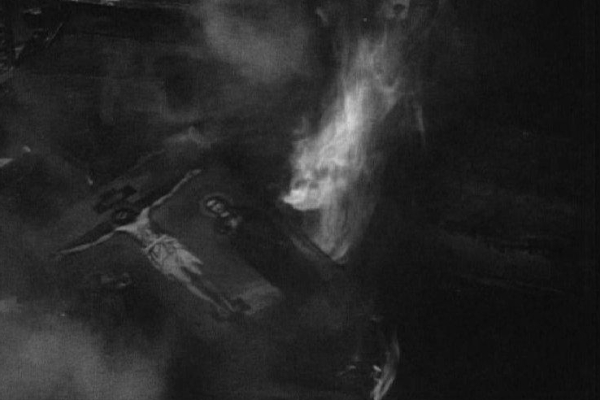
To return to an earlier point in this discussion (and to jump ahead to a later point in Vertov's career), there are quite a few statements (or slogans) of this kind planted across Man With a Movie Camera. That Man With a Movie Camera tells its story unaided by intertitles does not mean that our reading eye is left without work. Posters and street signs shout at us from almost every corner. Smaller inscriptions of different varieties—documents, instructions, or epitaphs—swarm Man With a Movie Camera like so many buzzing insects. We tend to pay no more attention to them than we do in real life, but this is our mistake: the film not merely transmits these words, it transforms them into stand-ins for the absent intertitles—so much so that one review included in this book even accused Vertov of cheating.2 Indeed, we do not find many instances when such writings are neutral—more often, they either chime in ironically with the life that surrounds them, or are given the role of miniature manifestos of the kind we have witnessed in Stride, Soviet! I have written extensively elsewhere3 on the Russian film poster for the German film The Awakening of Woman (Das Erwachen des Weibes, 1927, released in the Soviet Union in 1928) featured at various points in Vertov's film, and one day I plan to attempt a substantial essay on the tangle of allusions encased in that puzzling shot in Man With a Movie Camera in which the camera lens looks at us from under the shop sign "Expert Shoeblack from Paris."
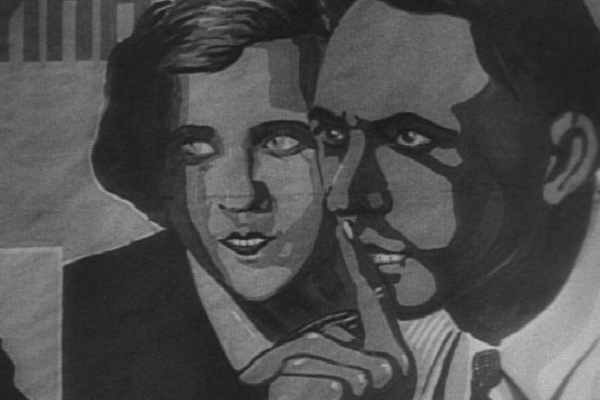
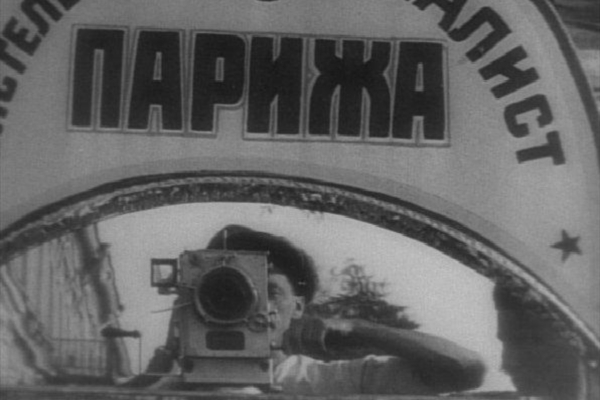
At this time, however, all I can afford is a quick comment on two shots—one at the beginning, the other at the end of reel 6, the last reel of Vertov's Man With a Movie Camera. Both shots tellingly illustrate two points: first, how porous Vertov has made the frontier between words and images; second, how ready he was to tamper with images to play with words. The shot I wish to look at first (at the beginning of the reel) is a pan that enables the viewer to juxtapose two names: the name of a movie house and the name of the movie showing there.
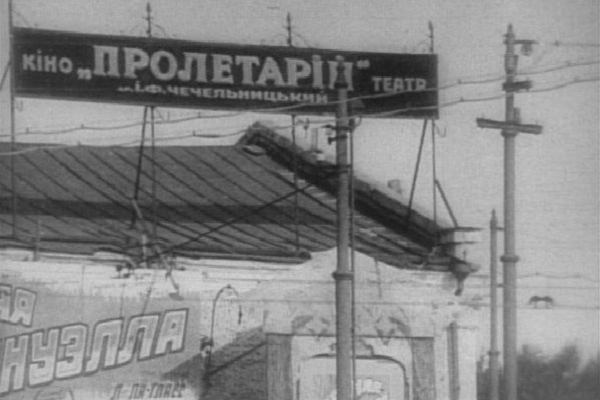
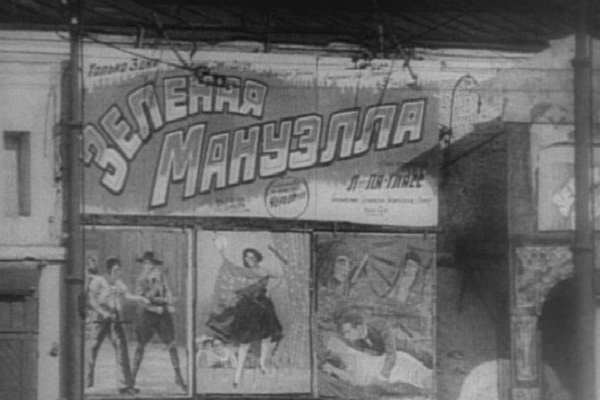
The name of the theatre is the Proletarian, the title of the film, The Green Manuela.4 One hardly needs to be reminded of the high status of the word "proletarian" in the Soviet 1920s, but just in case it may not quite come across in English, to the Russian ear the name "Manuela" sounds outlandish and seedy—add "Green" to it, and, regardless of what the film is about,5 its title sounds like something one is more likely to come across in a bordello than find pasted on a proletarian movie theatre. We are familiar with Vertov's usual derogatory sneer towards fiction films, but in this case the joke is less on the existence of fiction films per se than on their wide distribution in the territories of the USSR, whose unprincipled policy, Vertov's swift pan tells us, sometimes makes really strange bedfellows.
I cannot refrain from adducing a curious parallel from an essay entitled "Anti-cine-dote" by Osip Brik, the editor of the Left Front magazine Novyi LEF in which Brik's essay was published in early 1927.6 Brik was not exactly Vertov's friendliest critic (so little so, that two of Brik's reviews of Vertov's films provoked violent letters of protest on Vertov's part), but on the general matters of art and film, and of what State policy should be in respect to film distribution, the Kinocs and the LEF (Levyi front iskusstv: Left Front of the Arts)—Vertov and Brik—were, if not of the same, then of like mind. The essay by Brik which I am citing was precisely about this—the poison of philistine taste dissolved through the repertoire of Soviet film theatres, and how Sovkino (Russia's largest distribution company) was helping to inject this poison by importing the cheesiest kinds of films from the West. It is well known (at least, it was at the time) that Lenin, in a conversation with the Commissar of Enlightenment Anatoly Lunacharsky about possible State support of the arts during this period of economic hardship, once made this remark: "Of all your arts, cinema for us is the most important." It is hard to say whether he meant important educationally, or in terms of film propaganda—perhaps both—but it is unlikely that what Lenin had in mind was cinema's economic importance. Meanwhile, it seems, Brik's essay speculates, that this is exactly how Soviet film distributors interpreted Lenin's dictum:
I once saw these words of Lenin written in large letters on a banner hanging at the front of one of our provincial film theaters, and pasted under it was a poster advertising some trashy foreign film entitled The Green Manuela. Lenin's pronouncement attached to a Green Manuela is not something endemic to our province; this behaviour is usual for the film distribution industry across the entire USSR. Lenin's words are used not as a direction for cultural policy, but as one would a publicity stunt.7
The reason why I recall this passage is not to say that Vertov, too, may have remembered it when he shot this pan from Man With a Movie Camera (he may, or he may not have), but rather to remind us, once again, of the extent to which Vertov's movies are indebted to their time—to their time's topical emblems, and to their time's typical way of juggling topical emblems into topical statements. We have seen how craftily Vertov quibbles with "found texts"—posters, signs, book covers—in his attempts to get some of those statements across, yet in order to do so, word games like this were not the only usable vehicle. Wordless pictures could serve this purpose as well, though it is true that such efforts would sometimes result in nonplussing the viewer—not only some later interpreters, but some of Vertov's contemporaries as well. Rid of words, visual statements could not be so easily taken as read—they had to be read as a riddle.
There is no better example of this than that memorable shot at the end of Man With a Movie Camera, in which a classical building with an eight-column portico topped by Apollo's four rampant horses suddenly implodes, and is levelled to the ground in front of the viewer's eyes.
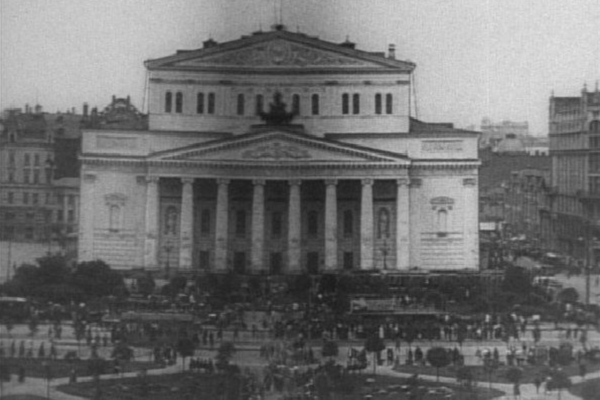
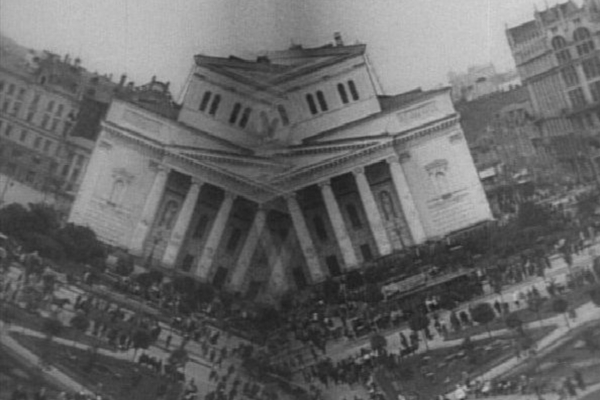
While there is little about this structure that may strike an outsider as unique, an inhabitant of Moscow will quickly identify it as the Bolshoi—the home of the Bolshoi Academic (formerly Imperial) Theater, just across the street (plus two or three squares) from the Kremlin. Given that the actual building never collapsed, Vertov's shot looks much like a teaser—all the more so if you look at it from the vantage point of later time. There is probably an amount of historiographic exaggeration in the phrase I am now going to quote, but this is what one Soviet critic from the 1960s, Sergei Drobashenko, wrote in his introduction to the first book of Vertov's writings: "For several decades film scholars have been trying to explain the well-known shot from Man With a Movie Camera, which shows how the Bolshoi Theatre splits. Many of them, giving up in despair, declared this scene to be "nonsense," "an optical illusion," "a magicians trick," etc."8 Vertov's tricks may look odd, but they are never inconsequential, the author justly objects to these unnamed scholars,9 and explains: through this shot Vertov meant to convey the mental collapse of the man in the street, overwhelmed by the tempo of the modern city.
That this explanation is hardly more satisfying is not just because it is inferential, but mainly because it addresses one-half of the problem, the splitting, leaving the question of "why the Bolshoi?" not only unanswered, but unasked. If there is a solution to Vertov's riddle shot, it is not to be found in Vertov's film per se, but in the give-and-take between Vertov's film and Vertov's time. In the 1920s the Bolshoi Theater was no longer what it had been in the previous hundred years of its existence. Along with some other innocuous objects and artefacts from the Imperial era, soon after 1917 the Bolshoi was caught in a process which I venture to call "revolutionary symbolization." In some cases—like ours—this symbolization could take the form of symbolic destruction, and in some instances (less numerous than our historical imagination paints them) this symbolic destruction was reified through a physical one. Not that this kind of destructionist symbolism was something endemic to Russia, or to the 20th century. The symbolic burning of the Bible and pulp fiction in Stride, Soviet! to which I referred earlier was Vertov's unintended tribute to the tradition of Savonarola (whose "bonfires of the vanities" spread to anything but the Bible, of course), as were the actual burnings of Church utensils recorded in Vertov's Kino-Pravda. Likewise, the symbolic destruction of sculptured monuments, about which historians and history itself frequently remind us, was not invented in 1917: a French contemporary print showing the statue of Louis XIV being toppled in the Place des Victoires in Paris in 1792 bears an amazing resemblance to similar scenes we may remember from Eisenstein's October, or from watching live news on CNN.10
It was less frequent, however, that public buildings—including one perceived as a notorious epitome of the old regime—would be put on Death Row, as it were. Unlike old statues, old buildings could be put to new uses, for, as revolutionary leaders were right to assume, their former authority did not undermine but rather contributed to the authority of the new. To replace a few crosses with Red stars was about all it took to turn the Kremlin, the ancient seat of the Russian Tsars, into the residence of the Bolshevist leaders. Likewise, without changing its outer appearance, the former Imperial Winter Palace in St. Petersburg could be transformed—as it was after 1917—into an art museum (the Hermitage).
But it is here that a new problem—this one more specific to the Russian situation—crops up. Wise though the latter solution may have appeared to the prudent mind, it was bound to disappoint the radical artist. To people like Kazimir Malevich or Aleksandr Rodchenko (and, later, to Dziga Vertov), it was just a matter of course that the political revolution of their day brought in its wake a revolution in the arts. For them, it went without saying that there is no room for art in the People's Republic—let alone the kind of art enshrined in the Imperial Winter Palace. There is hardly an easier way of illustrating this rather common presumption than by alluding to the closing lines of the poem "Too Early to Celebrate," by Vladimir Mayakovsky (then one of the Kom-Futs—"Communist-Futurists"), published in 1918 in the Left-wing art paper Iskusstvo kommuny (Art of the Commune)—a poem in which the former Imperial Winter Palace is wishfully converted into a pasta-making factory:
We protect old junk in the name of art.
Could it be that
the tooth of the revolution
has been blunted by the crowns?
Quick!
Spread the smoke of a macaroni factory
over the Winter Palace.
We have fired our guns for a day or two,
and we think —
we'll lick the old.
Nothing to brag about so far!
To change your outer coat
is not enough, comrades!
Turn your guts inside out!11
But hardly any former Imperial institution had grown into an issue as polarizing as the Bolshoi. It even caused a heated exchange between Lenin and his otherwise loyal Commissar of Enlightenment Anatoly Lunacharsky, who later characterized Lenin's attitude towards this theatre as "very nervous". One constantly debated question was whether the art they had inherited was worth the expense that came with it; another—not asked so much as lurking behind the debates—was whether it was of much use anyway. A theatre of this calibre was not a cheap thing to maintain; it housed a ballet, an opera troupe, and a big orchestra, to say nothing of the workforce. Formerly, all this was supported by the Crown. Now that the Bolshoi belonged to the People, the question arose whether the People could afford it—or wanted to. In 1919, when the issue was first tackled, Lenin did not insist on closing it, but its subsidy was cut significantly. The question "whether we need the Bolshoi Theater" (the original phrasing) resurfaced in late 1921 (the year in which Lenin inaugurated the New Economic Policy): in November the official Party paper Pravda (Truth) raised it three times—and in three different registers. On the 10th it informed its readers of a public discussion at the House of the Press in which some famous and less-famous figures among the workers of culture (including Mayakovsky and Vsevolod Meyerhold) expressed their opinions (from other sources we know that Mayakovsky was for, and Meyerhold against, the closing).12 On the 11th it published a rather biased account of a session at the Commissariat of Enlightenment13 on 9 November in which Lunacharsky—its head—is quoted as saying: "Every month around two billion roubles is spent to upkeep this theatre, which would be enough to hire four thousand schoolteachers if we pay each of them half a million a month, something which they are not getting now."14 And, on 15 November, the paper published a summary of letters ostensibly received from workers' collectives and "Young Communist cells," most of whom refused to acknowledge the Bolshoi as theirs.
Apparently, all this looked like the beginning of a campaign. Lunacharsky (known as a supporter of the arts) acted promptly by raising the Bolshoi question at another session of the Soviet of People's Commissars (the equivalent of a ministerial cabinet of the Soviet government), which voted unanimously for the Bolshoi Theatre to be preserved. This prompted an angry letter from Lenin (dated 12 January 1922) to the Politburo demanding that the vote be revoked, and reminding Lunacharsky and all other People's Commissars that resolutions involving ideological matters were the prerogative of the Party, and not of the Government. The vote was revoked, but Lunacharsky did not give up. In a long letter to Lenin, he explained that the Bolshoi was still remembered in the West; that if 2,000 people a day, including 500 workers (apparently there was a quota), were allowed to spend time in a warm lighted space listening to good music the money was well spent; and while it was true that the closing of the Bolshoi would free up funds that could be spent on education, the number of people employed at the Bolshoi was the equivalent of a small provincial town, and the State subsidy would allow them to earn their living by their specialized labor.15 The Bolshoi saga lasted until 14 March 1922, when a new resolution—this time at the right level, a session of the Politburo—was finally passed, stating that the closing of the theatre was "economically unfounded".16
Let me repeat: economy was just one of two aspects of the problem, the other being an air of ideological nervousness which surrounded the Bolshoi issue, something less easy to formulate in the bureaucratic vocabulary of directives and resolutions. This other aspect comes across in Lunacharsky's autobiographical essay "Lenin and Art". There were two motives, Lunacharsky claims, behind Lenin's desire to get rid of the Bolshoi:
One he named right away. It is embarrassing, Lenin said, to waste money on a luxurious theatre like this while we don't have enough for simple country schools. The other suggested itself at one of the sessions at which I tried to defend the Bolshoi Theatre from his attack. Vladimir Ilich [Lenin] squinted cunningly and said: "And yet, it's a pure piece of the gentry's culture; no one can deny this." He felt that the pompous and courtly tone characteristic of the opera was something that belonged to the gentry as a class.17
It might be hard to judge how widely Lenin's attitude towards the Bolshoi and what he thought this theatre stood for was known before Lenin's death, but it surely became known in 1924, for this was when the memoir quoted above was first published. It must have been then, if not earlier, that the name (and image) of the Bolshoi acquired that second, situational, 1920s-specific connotation, which we must keep in mind when we find them—the name or the image—used by Left-wing writers and Left-wing filmmakers alike. This explains what Osip Brik, the leading theorist of the Left Front and factual editor of the Novyi LEF magazine, had in mind when he mentioned the Bolshoi in his speech at a LEF meeting in 1927. We Left-wingers, Brik said, should not expect to be pampered and understood by others, and we must not become impatient and hysterical when we hear other people refuse to listen to our ideas, and see them continue to act as dictated by habit or common sense. We ought to get used to that. "We have been saying for ten years that the Bolshoi Theatre must be closed, and yet this year it is being renovated."18 This also explains why Viktor Shklovsky, another leading theorist of the Left Front, who wrote the scenario for Abram Room's Bed and Sofa (Tretia Meschanskaia, 1927), made one of the film's two male protagonists—Kolya, a former Red Army hero turned petit bourgeois through his addiction to petty pleasures of everyday life—a repair worker hired to renovate the Apollo-horsed neoclassical facade of the Bolshoi building. This also explains why this building symbolically—wishfully—implodes at the end of Man With a Movie Camera, Vertov's last silent film, the last of the 1920s, and arguably the last avant-garde manifesto before the new style, known as Stalinist Neo-classicism, was ushered in.
1. And they had a point, as readers of English can now easily find out from a recent translation: The Keys to Happiness, by Anastasiia Verbitskaia, translated and edited by Beth Holmgren and Helena Goscilo (Bloomington: Indiana University Press, 1999). On the multiple cultural reasons for the rage caused by this notorious book, see Laura Engelstein's excellent study of Imperial Russia and its various rages, whose title ironically echoes Verbitskaia's novel: The Keys to Happiness: Sex and the Search for Modernity in Fin-de-Siècle Russia (Ithaca: Cornell University Press, 1992), pp. 104-114. Worse - and perhaps more importantly for Vertov - there was also a film (directed by Iakov Protazanov and Vladimir Gardin) called The Keys to Happiness (Kliuchi schastia) based on this novel in 1913, the first - if not the greatest - hit in the history of Russian pre-Revolutionary cinema. On the success of this film, see Louise McReynolds, Russia at Play: Leisure Activities at the End of the Tsarist Era (Ithaca/London: Cornell University Press, 2003), pp. 268-83).
2. Khrisanf Khersonsky, "Chelovek s kinoapparatom", Kino, 29 February 1929. See the translation of this review of Man with a Movie Camera in chap. 24 of this book.
3. Yuri Tsivian, "Man with a Movie Camera, Reel One: A Selective Glossary", Film Studies: An International Review, issue 2, Spring 2000, pp. 51-76.
4. Die Grüne Manuela - Ein Film aus dem Süden (1923, Gloria-Film, dir. E.A. Dupont), starring Lucie Labass as Manuela, distributed in the USSR after 1926.
5. Incidentally, the film features a patriotic Argentinian dancer who helps freedom-fighters in their struggle against the English.
6. Osip Brik, "Kinoprotivoyadie", Novyi LEF, no. 2, 1927, pp. 27-30.
7. Ibid., p. 27.
8. Sergei Drobashenko, "Teoreticheskie vzgliady Vertova" (Vertov's Theoretical Outlook), in Vertov, Statii, dnevniki, zamysly (Writings, Diaries, Projects), pp. 13-14.
9. It is likely that those scholars Drobashenko had in mind are Aleksei Fedorov-Davydov (see his "K Realistich- eskou iskusstvu: tvorcheskii put D. Vertova" [Towards Realist Art: Dziga Vertov's Creative Career], in Kino, no. 17, 30 March 1936), and Nikolai Abramov, the pioneer of Vertov studies to whose memory the present volume is dedicated (see Abramov's Dziga Vertov [Moscow: Izdatelstvo Akademii Nauk], 1962, pp. 105-13). Though neither uses the exact epithets cited by Drobashenko, both treated Man with a Movie Camera as Vertov's "formalist" mistake.
10. On the toppling of this statue, see E.H. Gombrich, "Sculpture for Outdoors", in his The Uses of Images: Studies in the Social Function of Art and Visual Communication (London: Phaidon, 1999), pp. 153-54. On a related subject in the history of Communist China, see W.T. Mitchell's "The Violence of Public Art: Do the Right Thing", in his Picture Theory: Essays on Verbal and Visual Representation (Chicago/London: University of Chicago Press, 1994), pp. 371-96. On the Russian case, see Susan Buck-Morss, Dreamworld and Catastrophe: The Passing of Mass Utopia in East and West (Cambridge: MIT Press, 2000), a useful study, despite the fact that it lumps two different monuments to Alexander III into one: the Moscow one destroyed in 1917, and the St. Petersburg one, which was never destroyed. As a result of this mistake, Eisenstein, who had meticulously reconstructed the tearing down of the former in October (1928), is falsely accused of falsifying history (not that he does not do that elsewhere in the film, it is true).
11. Iskusstvo kommuny, no. 1, 7 December 1918. Translated by Omry Ronen.
12. Kommunisticheskii trud, 12 November 1921.
13. The People's Commissariat of Enlightenment: Narodnyi komissariat prosveshcheniia, more commonly known in Russian in its abbreviated form, Narkompros; instituted on 26 October 1917.
14. Yu. Larin, "Bolshoi teatr" (The Bolshoi Theatre), Pravda, 11 November 1921.
15. Quoted from Albert Plutnik, "Azbuka dlia millionov" (ABC for Millions), Izvestiia, 23 August 1987.
16. Vladimir Lenin, Polnoe sobranie sochinenij (Complete Works) (Moscow: Gospolitizdat, 1962), vol. 54, p. 594.
17. "Lenin i iskusstvo: vospominaniia" (Lenin and Art: A Memoir), in A.V. Lunacharsky, Sobranie sochinenii v 8 t. T. 7. (Collected Works, in 8 Volumes), vol. 7 (Moscow: Khudozhestvennaia literatura, 1967), pp. 404-405. First published in Khudozhnik i zritel , nos. 2-3, 1924.
18. Novyi LEF, nos. 11-12, 1927, p. 70. ![]()
LATEST ARTICLES
-20140814-173707-thumb3.jpg)
Fighting Words
by Imogen Sara Smith
posted August 12, 2014

Fighting Words, Part 2
by Imogen Sara Smith
posted August 20, 2014

On the Margins: The Fil…
by Andrew Chan
posted August 12, 2014

Robin Williams: A Sense…
by David Schwartz
posted August 12, 2014
 Celluloid Manifesto
Celluloid Manifesto
KEYWORDS
Dziga Vertov | Russian cinema | silent film | documentary | USSR | Vladimir Lenin | TheaterTHE AUTHOR
Yuri Tsivian is the William Colvin professor in the departments of Cinema and Media Studies (chair), Art History, and Slavic Languages and Literatures at the University of Chicago. His books include Silent Witnesses: Russian Films 1908-1919 (BFI: London 1989), Early Cinema in Russia and its Cultural Reception (Routledge: London, 1994), and Approaches to Carpalistics: Movement and Gesture in Art, Literature and Film (NLO, Moscow, 2010). His new interest is in digital methods of film studies—see http://www.cinemetrics.lv
More articles by Yuri TsivianAuthor's Website: Cinemetrics

